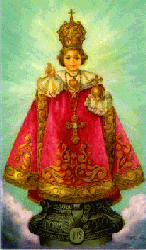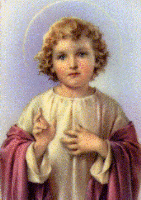THE HISTORY AND SPIRITUALITY
OF INFANT JESUS OF PRAGUE
Devotion to the Infant Jesus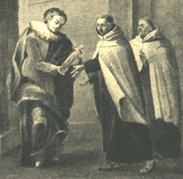
Individual depictions of the Child Jesus had their beginning in the 14th century. The oldest sculpture can be found in Germany where representative image had started in the visionary environment of women's convents. Usually the Child Jesus is holding in his hands various objects. With the right he mostly blesse, in the left hand he either holds a bird, an apple, a book, a cross or bunch of grapes, which is a reference to the Eucharisty. (J 15,1-11) In the middle Ages the sculptures were made of wood, where as in the baroque period they are of different materials like wax, ivory, bronze and others. In the baroque workshops, it became a habit to dress the statues. |
The Infant Jesus of Prague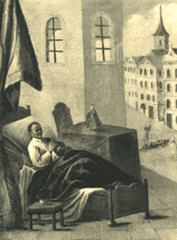 The cult of the Childhood Jesus's linked to the Baroque period. In it the Child Jesus plays the main part. Its history starts in Spain. It is the work of an unknown artist. It is believed that it comes from a convent between Cordoba and Seville and is a copy of a venerated wooden sculpture. There Dona Isabela Manrique de Lara a Mendoza obtained it. The sculpture then traveled as a wedding gift to her daughter Maria Manrique de Lara. She married a prominent Czech Nobleman Vojtech of Pernstejn. Again as a wedding gift to her daughter Polyxena who married Vilem of Rozumberk. She took the sculpture with her to her second mariage with Zdenek Vojtech of Lobkowicz. After his death, she donated the statue of the Child Jesus to the monastery of the Teresian Carmelites near the church of Virgin Mary Victorious in Prague Mala Strana. There it was placed first in the chapel, where it was venerated mainly by the novices.
At first the Infant Jesus was placed in the chapel of the Holy Rood. In 1741 because of the great number of pilgrims, it was transfered to the side altar of St. Joachim and St. Anne, opposite the miraculous picture of the Virgin Mary of Mantua. The Altar in its construction shows two lines. The vertical line goes from the Holy Ghoste via God the Father to the Child Jesus. The other - horizontal line passes from the Virgin Mary over the Child Jesus to St. Joseph. These represent the two levels of the human and the divine family. At that time small silver pieces like links were placed around as signs of thanksgiving. This peaceful time did not last long. After the death of the Empress Mary Theresa, her son Joseph II. followed her on the throne in Austria. He abolished the Carmelite monastery on July 3rd 1784. The church became a parish, that was administred by the Maltese Knights.
|
About the statue self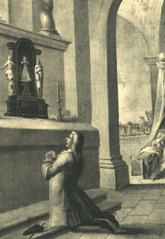 The wax figure is 47 cm High. It is protected from damage by a silver casing, that reaches to the waist. The sculpture has probably a wooden core covered with material, that can be seen through the wax. The Infant Jesus was always dressed. It is handed down that Anne Loragh and Mary Sibylla Schayemaier dressed it and then in 1747 the English Ladies. The Infant Jesus wears a white under shirt, over it a white rocheta then a silk top with frills around the neck and hands, the forth and fifth gown is like the priest's pluvial. On his head is placed a crown. The first crown is from the year 1767, the other from 1810 - 20. There have been more than 70 dresses donated. The oldest well-preserved are from 1700. One is donated by the Empress Mary Theresa. The Infant has also new dresses that are made even of white silon. Dresses come as gifts from all the world. |
Legends of the Infant Jesus of Prague
One of them is about the origin of the Infant . . . Further 3 legendary narratives are caught up in three paintings of a series of pictures of the Gracious Infant, that originated in the first half of the 18th century. They tell of the time, when the sculpture was found with broken arms in the waste in the church behind the High Altar. The miraculous Infant Jesus was greatly worshiped by the mighty and the simple, poor people. Also it is of interest, that the first imitations of the Infant Jesus of Prague were created by the sculptor Jan Schlansovsky in the 18th century. He also carved a mould by which hundreds of copies were made, which were sent throughout the whole world. Also our Misen China factury owns a mould that the sculptor Gottleb Kirchner created according to the famous sculptor J. J. Kandler. |
Miraculous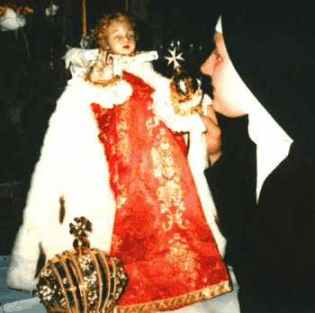 Records of miraculous phenomenon in conection with the sculpture of the Infant Jesus did not end sometime in the past. They occur even today. One happened to a two year old Tamara in Brazil. From birth she had disconnected hips and could only walk with difficulty with the help of a special equipment, which, by the way is kept in our church of Infant Jesus of Prague. She could hardly walk. The parents prayed a novena to the Infant Jesus of Prague and on the 6th day, she could take the first steps without the equipment that aided her. The doctors were astonished. The friends could not believe it. The whole family arrived in 1995 in this church, to thank the Miraculous Infant Jesus of Prague. Another case is the healing of an Indian woman, who had an accident in her youth, that paralyzed her. For a long time she had to rest in bed without moving. Once in a dream she saw the Infant Jesus and she understood, that she can be healed. She prayed the novena to the Infant Jesus, that someone ordered for her. While praying she started to observe that gradually the feeling come back to her feet and to her whole body. After a few weeks she was healed. In about 1994 she arrived here from USA as a 70-year-old grandmother with her husband and grandchild. All her life she had saved money for this trip to give thanksgiving to the Miraculous Infant Jesus of Prague.
|
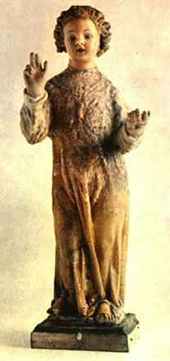 The childhood of Jesus is an active devotion in the Catholic church for nearly a thousand years. Christians always longed to show their deep reverence to the incarnate God, Jesus Christ. This veneration was stimulated aside from the Gospel also by apocryphal writings like f. i. James's and Thomas's pseudo gospels. The Child Jesus was adored by Church Fathers like St. Athanasius or St. Jerome. Other great worshipers of the Childhood Jesus's are St. Bernard of Chlairvaux, St. Francis of Assisi and St. Anthony of Padua. During the Baroque space it was first of all St. Teresa of Avila, who always traveled with her sculpture of the Infant Jesus during founding new convents. In Spain this cult had great devotion.
The childhood of Jesus is an active devotion in the Catholic church for nearly a thousand years. Christians always longed to show their deep reverence to the incarnate God, Jesus Christ. This veneration was stimulated aside from the Gospel also by apocryphal writings like f. i. James's and Thomas's pseudo gospels. The Child Jesus was adored by Church Fathers like St. Athanasius or St. Jerome. Other great worshipers of the Childhood Jesus's are St. Bernard of Chlairvaux, St. Francis of Assisi and St. Anthony of Padua. During the Baroque space it was first of all St. Teresa of Avila, who always traveled with her sculpture of the Infant Jesus during founding new convents. In Spain this cult had great devotion. 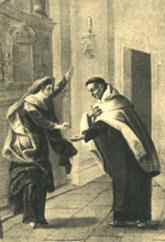 In the year 1631 the Saxons invaded Prague and the plundering did not bypass the monastery. The sculpture of the Child Jesus was thrown out with the waste behind the High Altar. Here Father Cyril a Matre Dei found it when he returned to the abandoned church in Mala Strana from München. The sculpture was damaged. After many attempts in vain, Father Cyril was happy to get some money from a Prague citizen for repairing the broken arms. The Infant Jesus thus became again the object of worship and a number of miracles were linked to the statue and also the protection of Prague from the Swedes.
In the year 1631 the Saxons invaded Prague and the plundering did not bypass the monastery. The sculpture of the Child Jesus was thrown out with the waste behind the High Altar. Here Father Cyril a Matre Dei found it when he returned to the abandoned church in Mala Strana from München. The sculpture was damaged. After many attempts in vain, Father Cyril was happy to get some money from a Prague citizen for repairing the broken arms. The Infant Jesus thus became again the object of worship and a number of miracles were linked to the statue and also the protection of Prague from the Swedes.  The family Martinic greatly worshiped the Infant Jesus. In 1651, under their leadership the sculpture was taken in procession from the church of Our Lady Victorious to all the churches in Prague. At this festivity it received the title Gratious. In 1655 the bishop of Prague crowned the Infant Jesus with a crown, that was ordered by Bernard Ignac of Martinic. In memory of this coronation a festive Mass is celebrated on the feast of the Ascention every year.
The family Martinic greatly worshiped the Infant Jesus. In 1651, under their leadership the sculpture was taken in procession from the church of Our Lady Victorious to all the churches in Prague. At this festivity it received the title Gratious. In 1655 the bishop of Prague crowned the Infant Jesus with a crown, that was ordered by Bernard Ignac of Martinic. In memory of this coronation a festive Mass is celebrated on the feast of the Ascention every year. 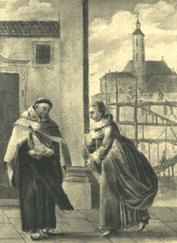 In the 19th century the fame of the miraculous Infant Jesus spread to the Spanish speaking countries of South America and Italy. And not only there! In some monastries they used a special liturgical prayer to the Infant Jesus of Prague. Many far away Asiatic countries are thanking the Infant Jesus for miracles, like the Philippines, China or Vietnam.
In the 19th century the fame of the miraculous Infant Jesus spread to the Spanish speaking countries of South America and Italy. And not only there! In some monastries they used a special liturgical prayer to the Infant Jesus of Prague. Many far away Asiatic countries are thanking the Infant Jesus for miracles, like the Philippines, China or Vietnam.  There are also legends narrated of the Infant Jesus of Prague. Can we possibly doubt their truthfulness, as they surely expressed how the people talked, lived and felt about the Infant Jesus?
There are also legends narrated of the Infant Jesus of Prague. Can we possibly doubt their truthfulness, as they surely expressed how the people talked, lived and felt about the Infant Jesus? 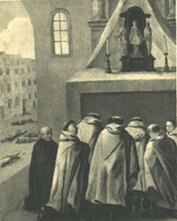
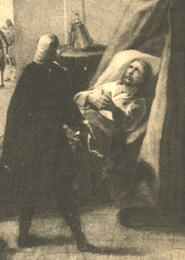 A further story tells how the Gracious Child helped the rich family of Henry Kolovrat of Libstejn. His wife lost her hearing and eye-sight. When she was touched with the Infant Jesus, she was restored to health. The lady, however was very selfish. She kept the Miraculous sculpture in her palace as a protection. But when she wanted to leave the palace, the horses would not move. The lady then rearlized that she must return the Infant Jesus to where it belongs. After that they could leave the palace easily.
A further story tells how the Gracious Child helped the rich family of Henry Kolovrat of Libstejn. His wife lost her hearing and eye-sight. When she was touched with the Infant Jesus, she was restored to health. The lady, however was very selfish. She kept the Miraculous sculpture in her palace as a protection. But when she wanted to leave the palace, the horses would not move. The lady then rearlized that she must return the Infant Jesus to where it belongs. After that they could leave the palace easily. ![40kb jpg holy card of the Infant Jesus, artist unknown; if you have information on this image, please email me [the Infance Jesus of Prague]](http://www.catholic-forum.com/saints/sainti16.jpg)

